
20 January 2025
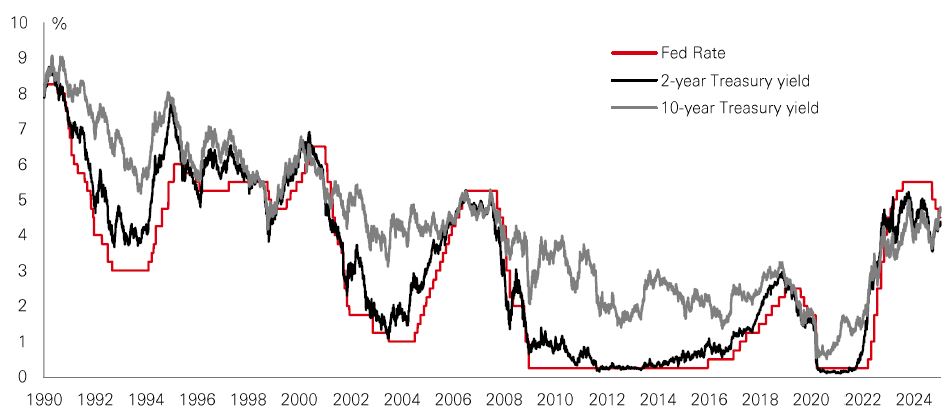
Developed market government bonds have lost significant ground in recent months. The benchmark US 10-year Treasury yield reached 4.8% mid-week; a level last seen in October 2023. UK 10-year Gilt yields rose to 4.9%; their highest level since 2008. But what does the threat of bond yields crossing 5% mean for investors?
Some macro market onlookers are calling this the “reverse conundrum”. It’s a play on the “conundrum” first termed by Alan Greenspan to describe stubbornly-low long bond yields in the face of 17 Fed rate hikes through to mid-2006. Today’s “reverse conundrum” is this process flipped around… despite Fed cuts, bond yields are on the rise.
The rise is down to a combination of fiscal concerns, bond issuance worries, and, to some extent, investor nervousness about policy mistakes. Relative to recent history, the pattern is unusual and if the “reverse conundrum” holds, it could signal that we have entered a new economic and market regime. We would no longer be in the era of low bond yields.
That could have profound implications for asset allocators. It would be a world where long bond yields would have to compensate investors for inflation and fiscal risks, with bonds no longer offering a guaranteed all-weather hedge for portfolios. Meanwhile, higher discount rates would create a pricing challenge for assets right across the risk curve (with skinny risk premiums particularly vulnerable to a re-pricing). That would leave investors seeking a new range of alternatives and private markets to build portfolio resilience. If this really is a “reverse conundrum” world, there would be a strong case for taking an active and opportunistic approach to investing in 2025.
The global listed real estate sector weakened late last year amid uncertainty over the timing of future Fed rate cuts. But some listed real estate analysis suggests parts of the European-listed market trade at an attractive discount to both other asset classes and the direct property sector. With private real estate capital markets showing signs of re-opening, investment volumes should continue to pick up, with listed property players well-placed to benefit.
In part, this is supported by the fact that REIT (Real Estate Investment Trust) balance sheets are currently in good shape, with low leverage.
Given that European economic growth is forecast to lag other regions this year, some specialists favour sectors less reliant on growth to deliver returns. They include those with secular tailwinds like senior housing, and sectors with embedded income growth like industrial warehouses. Dividend yields from global real estate equities are standing at a premium to wider equities.
The value of investments and any income from them can go down as well as up and investors may not get back the amount originally invested. Past performance does not predict future returns. For informational purposes only and should not be construed as a recommendation to invest in the specific country, product, strategy, sector, or security. Any views expressed were held at the time of preparation and are subject to change without notice. Any forecast, projection or target where provided is indicative only and is not guaranteed in any way. The level of yield is not guaranteed and may rise or fall in the future. Source: HSBC Asset Management. Macrobond, Bloomberg. Data as at 7.30am UK time 17 January 2025.
Despite a backdrop of volatile rates, policy uncertainty, and geopolitical stress, global corporate credit spreads currently trade at close to 30-year tights. This tightening has been driven by a combination of strong fundamentals and stable technical demand. Spreads have been underpinned by robust profits growth and continuing evidence of US economic resilience, particularly in the labour market. With US rates still elevated – and further policy easing now being priced-out by the market – high credit yields have been a major attraction for fixed income investors. This ensured that a record supply of bond issuance last year was soaked up by keen demand. |
In a higher-for-longer rate scenario, riskier credits may be vulnerable as more leveraged firms struggle to cover interest expenses or as economic growth cools. Floating rate spread products, like securitised credit or private credit, should maintain their yield advantage.
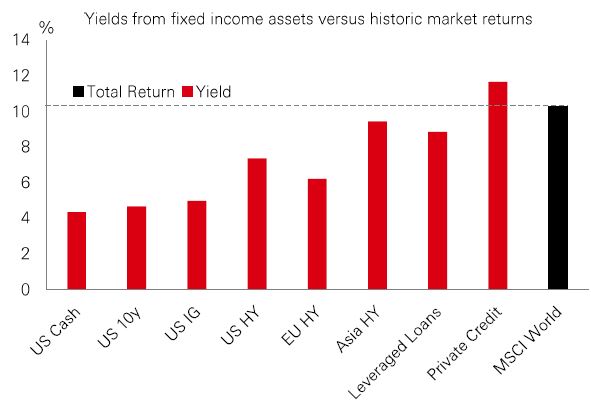
The S&P 500 has delivered back-to-back annual gains of nearly 25% over the past two years. Last year, analysts pencilled-in an expected 2024 index price gain of only mid-single-figures. That was too bearish, and it proved once again that full-year price forecasting is notoriously difficult. This year, analysts think the index will gain around 10%. In 2024, resilient profits, the strong performance of ‘Magnificent 7’ stocks, and expectations of revitalised US growth under the incoming administration were key drivers of returns. With Q4-24 earnings season now under way, we should get a sense of whether that can continue. Financial stocks are among the first to report, with Factset data showing that they are expected to see the highest quarterly year-on-year profits growth rate of all 11 sectors, at 39.5%. Overall, index profits are expected to grow by 11.7% yoy in Q4 (and by around 14.5% yoy in CY2025). |
One catch is that strong recent sentiment in the S&P 500 has driven valuations higher. The index currently trades on a forward 12-month P/E ratio of 22x (above its 10-year average of 18x).
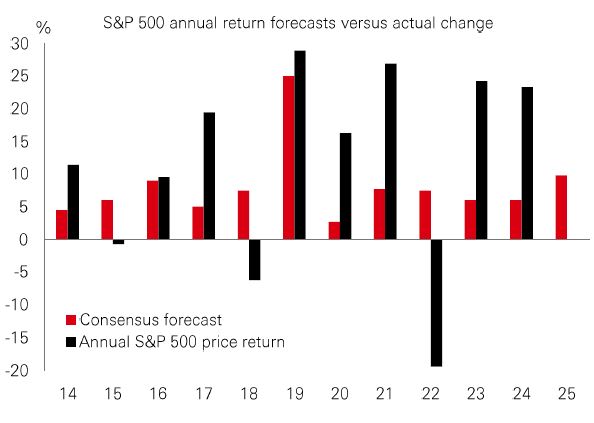
Brazilian bonds and the real (BRL) have been under pressure in recent months. There have been clear drivers behind recent moves, with the structural fiscal picture remaining a concern. Just to stabilise public debt relative to GDP, Brazil needs a primary surplus of 2% of GDP. At the end of Q3 2024, it had a budget deficit of 9.2%. The road to sustainability is both long and difficult. Yet, at least in the short term, it is tempting to consider whether Brazilian local-currency assets may have become oversold. From a policy perspective, Congress has approved most of the expenditure containment measures proposed last year, which can mitigate risks of further fiscal slippage. The finance ministry is working on further measures to reduce expenditure. |
The real yield (based on CPI inflation) on long-end Brazilian bonds is now over 10%, the highest since the 2008 global financial crisis.
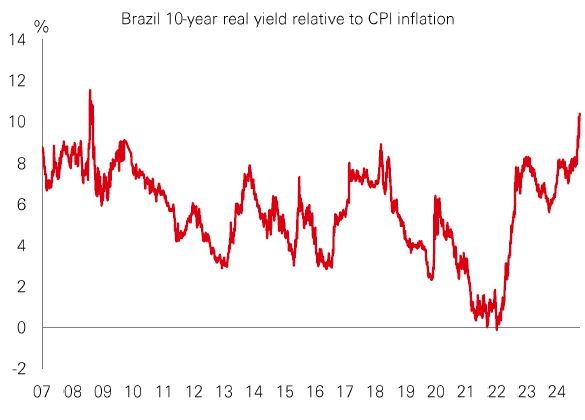
Past performance does not predict future returns. The level of yield is not guaranteed and may rise or fall in the future. For informational purposes only and should not be construed as a recommendation to invest in the specific country, product, strategy, sector, or security. Any views expressed were held at the time of preparation and are subject to change without notice. Any forecast, projection or target where provided is indicative only and is not guaranteed in any way. Index returns assume reinvestment of all distributions and do not reflect fees or expenses. Source: HSBC Asset Management. Macrobond, Bloomberg, Datastream. Data as at 7.30am UK time 17 January 2025.
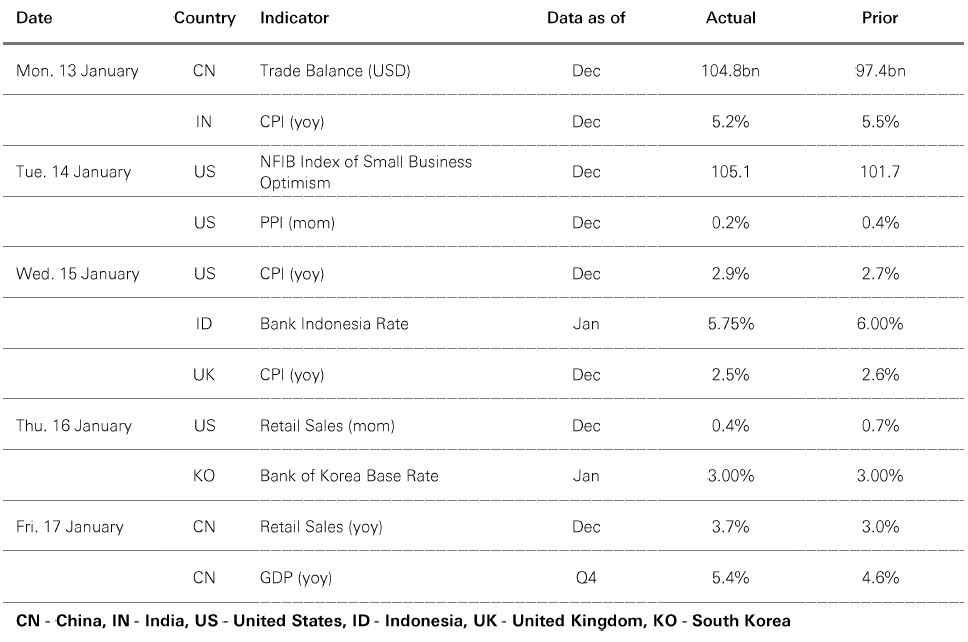
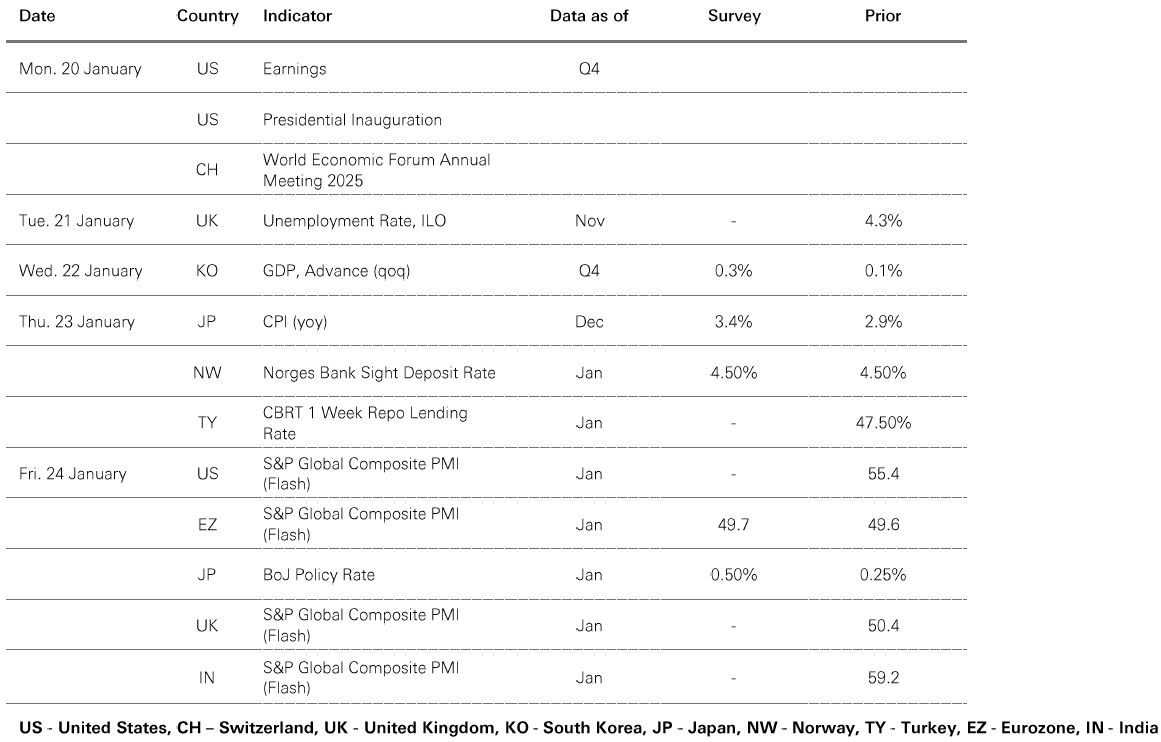
Source: HSBC Asset Management. Data as at 7.30am UK time 17 January 2025. For informational purposes only and should not be construed as a recommendation to invest in the specific country, product, strategy, sector or security. Any views expressed were held at the time of preparation and are subject to change without notice.
A benign US core CPI inflation print lifted risk appetite, with the US dollar consolidating ahead of US president-elect Trump’s inauguration. Core government bonds rose, with Gilts outperforming US Treasuries and Bunds, aided by a downside surprise in UK inflation. US equities exhibited broad-based strength, led by the small-cap Russell 2000 index. The Euro Stoxx 50 index posted solid gains, whereas Japan’s Nikkei 225 fell on a firmer yen, as investors raised expectations for a January BoJ rate hike. Other Asian stock markets were mixed. Strength was most evident in the Shanghai Composite and Hang Seng indices. South Korea’s Kospi reversed early losses last week as the BoK signalled further easing in the near term, despite keeping its policy rate on hold. India’s Sensex struggled to gain traction, with corporate earnings in focus. In commodities, rising supply concerns propelled oil prices to a five-month high, while gold and copper advanced.




This document or video is prepared by The Hongkong and Shanghai Banking Corporation Limited (‘HBAP’), 1 Queen’s Road Central, Hong Kong. HBAP is incorporated in Hong Kong and is part of the HSBC Group. This document or video is distributed and/or made available, HSBC Bank (China) Company Limited, HSBC Bank (Singapore) Limited, HSBC Bank Middle East Limited (UAE), HSBC UK Bank Plc, HSBC Bank Malaysia Berhad (198401015221 (127776-V))/HSBC Amanah Malaysia Berhad (20080100642 1 (807705-X)), HSBC Bank (Taiwan) Limited, HSBC Bank plc, Jersey Branch, HSBC Bank plc, Guernsey Branch, HSBC Bank plc in the Isle of Man, HSBC Continental Europe, Greece, The Hongkong and Shanghai Banking Corporation Limited, India (HSBC India), HSBC Bank (Vietnam) Limited, PT Bank HSBC Indonesia (HBID), HSBC Bank (Uruguay) S.A. (HSBC Uruguay is authorised and oversought by Banco Central del Uruguay), HBAP Sri Lanka Branch, The Hongkong and Shanghai Banking Corporation Limited – Philippine Branch, HSBC Investment and Insurance Brokerage, Philippines Inc, and HSBC FinTech Services (Shanghai) Company Limited and HSBC Mexico, S.A. Multiple Banking Institution HSBC Financial Group (collectively, the “Distributors”) to their respective clients. This document or video is for general circulation and information purposes only.
The contents of this document or video may not be reproduced or further distributed to any person or entity, whether in whole or in part, for any purpose. This document or video must not be distributed in any jurisdiction where its distribution is unlawful. All non-authorised reproduction or use of this document or video will be the responsibility of the user and may lead to legal proceedings. The material contained in this document or video is for general information purposes only and does not constitute investment research or advice or a recommendation to buy or sell investments. Some of the statements contained in this document or video may be considered forward looking statements which provide current expectations or forecasts of future events. Such forward looking statements are not guarantees of future performance or events and involve risks and uncertainties. Actual results may differ materially from those described in such forward-looking statements as a result of various factors. HBAP and the Distributors do not undertake any obligation to update the forward-looking statements contained herein, or to update the reasons why actual results could differ from those projected in the forward-looking statements. This document or video has no contractual value and is not by any means intended as a solicitation, nor a recommendation for the purchase or sale of any financial instrument in any jurisdiction in which such an offer is not lawful. The views and opinions expressed are based on the HSBC Global Investment Committee at the time of preparation and are subject to change at any time. These views may not necessarily indicate HSBC Asset Management‘s current portfolios’ composition. Individual portfolios managed by HSBC Asset Management primarily reflect individual clients’ objectives, risk preferences, time horizon, and market liquidity.
The value of investments and the income from them can go down as well as up and investors may not get back the amount originally invested. Past performance contained in this document or video is not a reliable indicator of future performance whilst any forecasts, projections and simulations contained herein should not be relied upon as an indication of future results. Where overseas investments are held the rate of currency exchange may cause the value of such investments to go down as well as up. Investments in emerging markets are by their nature higher risk and potentially more volatile than those inherent in some established markets. Economies in emerging markets generally are heavily dependent upon international trade and, accordingly, have been and may continue to be affected adversely by trade barriers, exchange controls, managed adjustments in relative currency values and other protectionist measures imposed or negotiated by the countries with which they trade. These economies also have been and may continue to be affected adversely by economic conditions in the countries in which they trade. Investments are subject to market risks, read all investment related documents carefully.
This document or video provides a high-level overview of the recent economic environment and has been prepared for information purposes only. The views presented are those of HBAP and are based on HBAP’s global views and may not necessarily align with the Distributors’ local views. It has not been prepared in accordance with legal requirements designed to promote the independence of investment research and is not subject to any prohibition on dealing ahead of its dissemination. It is not intended to provide and should not be relied on for accounting, legal or tax advice. Before you make any investment decision, you may wish to consult an independent financial adviser. In the event that you choose not to seek advice from a financial adviser, you should carefully consider whether the investment product is suitable for you. You are advised to obtain appropriate professional advice where necessary.
The accuracy and/or completeness of any third-party information obtained from sources which we believe to be reliable might have not been independently verified, hence Customer must seek from several sources prior to making investment decision.
The following statement is only applicable to HSBC Mexico, S.A. Multiple Banking Institution HSBC Financial Group with regard to how the publication is distributed to its customers: This publication is distributed by Wealth Insights of HSBC México, and its objective is for informational purposes only and should not be interpreted as an offer or invitation to buy or sell any security related to financial instruments, investments or other financial product. This communication is not intended to contain an exhaustive description of the considerations that may be important in making a decision to make any change and/or modification to any product, and what is contained or reflected in this report does not constitute, and is not intended to constitute, nor should it be construed as advice, investment advice or a recommendation, offer or solicitation to buy or sell any service, product, security, merchandise, currency or any other asset.
Receiving parties should not consider this document as a substitute for their own judgment. The past performance of the securities or financial instruments mentioned herein is not necessarily indicative of future results. All information, as well as prices indicated, are subject to change without prior notice; Wealth Insights of HSBC Mexico is not obliged to update or keep it current or to give any notification in the event that the information presented here undergoes any update or change. The securities and investment products described herein may not be suitable for sale in all jurisdictions or may not be suitable for some categories of investors.
The information contained in this communication is derived from a variety of sources deemed reliable; however, its accuracy or completeness cannot be guaranteed. HSBC México will not be responsible for any loss or damage of any kind that may arise from transmission errors, inaccuracies, omissions, changes in market factors or conditions, or any other circumstance beyond the control of HSBC. Different HSBC legal entities may carry out distribution of Wealth Insights internationally in accordance with local regulatory requirements.
Important Information about the Hongkong and Shanghai Banking Corporation Limited, India (“HSBC India”)
HSBC India is a branch of The Hongkong and Shanghai Banking Corporation Limited. HSBC India is a distributor of mutual funds and referrer of investment products from third party entities registered and regulated in India. HSBC India does not distribute investment products to those persons who are either the citizens or residents of United States of America (USA), Canada or New Zealand or any other jurisdiction where such distribution would be contrary to law or regulation.
The following statement is only applicable to HSBC Bank (Taiwan) Limited with regard to how the publication is distributed to its customers: HSBC Bank (Taiwan) Limited (“the Bank”) shall fulfill the fiduciary duty act as a reasonable person once in exercising offering/conducting ordinary care in offering trust services/ business. However, the Bank disclaims any guarantee on the management or operation performance of the trust business.
The following statement is only applicable to PT Bank HSBC Indonesia (“HBID”): PT Bank HSBC Indonesia (“HBID”) is licensed and supervised by Indonesia Financial Services Authority (“OJK”). Customer must understand that historical performance does not guarantee future performance. Investment product that are offered in HBID is third party products, HBID is a selling agent for third party product such as Mutual Fund and Bonds. HBID and HSBC Group (HSBC Holdings Plc and its subsidiaries and associates company or any of its branches) does not guarantee the underlying investment, principal or return on customer investment. Investment in Mutual Funds and Bonds is not covered by the deposit insurance program of the Indonesian Deposit Insurance Corporation (LPS).
Important information on ESG and sustainable investing
Today we finance a number of industries that significantly contribute to greenhouse gas emissions. We have a strategy to help our customers to reduce their emissions and to reduce our own. For more information visit www.hsbc.com/sustainability.
In broad terms “ESG and sustainable investing” products include investment approaches or instruments which consider environmental, social, governance and/or other sustainability factors to varying degrees. Certain instruments we classify as sustainable may be in the process of changing to deliver sustainability outcomes. There is no guarantee that ESG and Sustainable investing products will produce returns similar to those which don’t consider these factors. ESG and Sustainable investing products may diverge from traditional market benchmarks. In addition, there is no standard definition of, or measurement criteria for, ESG and Sustainable investing or the impact of ESG and Sustainable investing products. ESG and Sustainable investing and related impact measurement criteria are (a) highly subjective and (b) may vary significantly across and within sectors.
HSBC may rely on measurement criteria devised and reported by third party providers or issuers. HSBC does not always conduct its own specific due diligence in relation to measurement criteria. There is no guarantee: (a) that the nature of the ESG / sustainability impact or measurement criteria of an investment will be aligned with any particular investor’s sustainability goals; or (b) that the stated level or target level of ESG / sustainability impact will be achieved. ESG and Sustainable investing is an evolving area and new regulations are being developed which will affect how investments can be categorised or labelled. An investment which is considered to fulfil sustainable criteria today may not meet those criteria at some point in the future.
THE CONTENTS OF THIS DOCUMENT OR VIDEO HAVE NOT BEEN REVIEWED BY ANY REGULATORY AUTHORITY IN HONG KONG OR ANY OTHER JURISDICTION. YOU ARE ADVISED TO EXERCISE CAUTION IN RELATION TO THE INVESTMENT AND THIS DOCUMENT OR VIDEO. IF YOU ARE IN DOUBT ABOUT ANY OF THE CONTENTS OF THIS DOCUMENT OR VIDEO, YOU SHOULD OBTAIN INDEPENDENT PROFESSIONAL ADVICE.
© Copyright 2025. The Hongkong and Shanghai Banking Corporation Limited, ALL RIGHTS RESERVED.
No part of this document or video may be reproduced, stored in a retrieval system, or transmitted, on any form or by any means, electronic, mechanical, photocopying, recording or otherwise, without the prior written permission of The Hongkong and Shanghai Banking Corporation Limited.